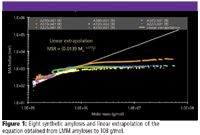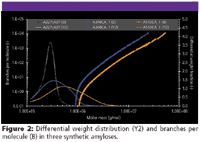Branching in High Molar Mass Synthetic Amyloses
Amylose is an occasionally-branched biopolymer and, together with amylopectin, the hyper-branched component, a constituent of starch. Determination of branching in amylopectin on the basis of amyloses may be performed with the help of synthetic amyloses. Synthetic amyloses from enzymatic (phosphorolytic) reaction were checked for their linearity.
Amylose is an occasionally-branched biopolymer and, together with amylopectin, the hyper-branched component, a constituent of starch. Determination of branching in amylopectin on the basis of amyloses may be performed with the help of synthetic amyloses. Synthetic amyloses from enzymatic (phosphorolytic) reaction were checked for their linearity.
Synthetic amyloses were dispersed 1 M KOH (RT, 100mg/ml), diluted with water, filtered at 0,22μm, agitated for 24h under Argon, and ultracentrifuged at 100kxg. The SEC columns were Shodex OHpak HQ806, 805, 804-803, from Showa Denko, Tokyo, Japan, and a DAWN DSP (He-Ne laser, wavelength 632.8nm) and Optilab DSP were used as detectors. Eluant was 0.3 M NaNO3, pH 10, flow rate 0.5ml/min.
The molar mass averages M (Mw), and root mean square radius R (Rw) were calculated by the Zimm method, RI increment dn/dc=0.146 ml/g. First order fit with respect to M and R. Second virial coefficient A2 = 0. Slice size 6.25μl. Raw data were imported to Corona 1.40, at least three data sets/sample were averaged.
Average molar mass parameters were assigned using the ASTRA Debye plot option. Averaged raw data were re-imported to Corona. Linear equations for narrow distributed amyloses in the low M range (LMM) calculated to the best fit. Linear extrapolation of the resulting equation in the double logarithmic plot of R vs. M up to 1x108 g/mol was established. Branching calculations [Branching ratio gM, branches per molecule B and long term branching λ] were performed by the Zimm-Stockmayer equations (trifunctional random branching).

Figure 1
The Mw of LMM synthetic amyloses are narrow, and the branching calculations show strictly linear polymers. HMM amyloses show a broader distribution and a "contraction" of R with increasing M, that indicates that branching increases with increasing M (Fig.1). Branching starts (B=e0 ) at approximately 8x105 gmol-1 (Fig.2). The origin of branching during the enzymatic reaction remains to be investigated. The method has proved to be useful to check branching in HMM biopolymers on the basis of linear LMM biopolymers.

Figure 2
This note graciously submitted by Claudia Niemann, Technical University Berlin, Germany
DAWN® , miniDAWN® , ASTRA® , Optilab® and the Wyatt Technology logo are registered trademarks of Wyatt Technology Corporation.

Wyatt Technology Corporation
6300 Hollister Avenue
Santa Barbara, CA 93117
TEL (805) 681-9009; FAX (805) 681-0123
E-mail: info@wyatt.com
URL http://www.wyatt.com

The Benefits of Custom Bonded Silica
April 1st 2025Not all chromatography resins are created equal. Off-the-shelf chromatography resins might not always meet the rigorous purification requirements of biopharmaceutical manufacturing. Custom bonded silica from Grace can address a wide range of separation challenges, leading to real performance improvements. Discover more about the latest innovations in chromatography silica from Grace, including VYDAC® and DAVISIL®.
5 Things to Consider When Selecting a Chromatography Silica
April 1st 2025Particularly in the pharmaceutical industry, drug purity isn’t just a goal – it’s essential for achieving safety, stability and efficacy. However, purification is easier said than done, especially with challenging molecules like DNA and RNA “oligonucleotides,” due in large part to their diversity and the range of impurities that can be generated during production. Enter DAVISIL® chromatographic silica, with a wide range of pore diameters and particle sizes to meet your specific application, performance and sustainability requirements. Before you choose the chromatography resin for your next purification application, take a look at these 5 considerations.
Automating Protein Purification: Efficiency, Yield, and Reproducibility
March 27th 2025Recent advancements in automated protein purification stress the importance of efficiency, scalability, and yield consistency. This eBook compares different purification platforms, highlighting their impact on downstream applications and demonstrating how automation enhances throughput and process control.
MilliporeSigma: Ultrapure Water for Sensitive LC-MS Analysis of Pesticides
March 25th 2025The aim of the study was to illustrate the efficiency of Milli-Q® water purification systems in eliminating pesticides from tap water, thereby producing and delivering reliable and consistent-quality ultrapure water suitable for pesticides analysis














